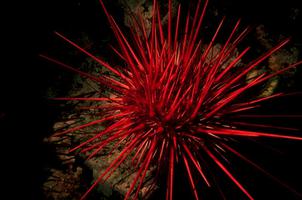Echinodermata [Gk "spiny skin"], phylum of exclusively marine invertebrate animals. The 6000 known species occur from shores to greatest depths of all oceans. None are found in fresh water; very few are capable of coping with diluted seawater of estuaries. The name is derived from the characteristic internal skeleton of calcium carbonate formed into numerous small, bony structures (ossicles). Ossicles are embedded in the skin, often giving it a rough or spiny texture.
There are 5 classes of living echinoderms: crinoids (sea lilies and feather stars); asteroids (starfish); ophiuroids (brittle stars); echinoids (sea urchins, etc); and holothuroids (sea cucumbers). Echinoderms have been well preserved as fossils; all existing classes and several others now extinct were present in the Ordovician (505-438 million years ago). They may have originated in the Precambrian (over 570 million years ago).
Living classes differ principally in body plan. All show radial symmetry (symmetry about an axis), but there are many variations. In general, the axis of symmetry runs between the oral and aboral surfaces (sides bearing mouth and anus respectively). Crinoids, asteroids and ophiuroids are basically star-shaped; the axis of symmetry is vertical. In asteroids and ophiuroids, the oral surface is usually directed downwards, in crinoids, upwards.
Sea urchins are spherical, with the oral surface downwards. Holothuroids are sausage-shaped and, typically, lie on one side; oral and aboral surfaces are at either end. Fundamentally, echinoderms are composed of 5 radially arranged parts. This configuration, most apparent in the star-shaped asteroids and ophiuroids, also occurs in echinoids and holothuroids, which typically have body parts in some multiple of 5.
Another characteristic is the water-vascular system, an arrangement of tubes and canals using hydrostatic pressure to operate tube feet. Water within ampullae (small sacs resembling medicine-dropper bulbs) is squeezed out by muscular contraction, causing the tube feet to elongate. Contraction of muscles in the tube feet walls causes retraction of feet and return of water to the ampullae. Tube feet usually occur in rows radiating out from the oral surface. They function in locomotion, feeding and respiration.
Crinoids
Crinoids are the oldest and most primitive living class of echinoderms. Their common name, sea lilies, derives from the fact that some species are attached to the sea bottom by a stalk. Long, feathery arms surrounding the mouth give the appearance of a lilylike flower. Crinoids that have lost this sessile lifestyle and no longer have a stalk are commonly called feather stars. Crinoids usually feed on suspended particles that fall on their oral surface. Some feather stars swim by thrashing arms up and down. In a comical, unco-ordinated manner, they can lift themselves off the bottom and avoid predators.
Asteroids
Asteroids (starfish or sea stars) are common seashore animals. Starfish are voracious carnivores. Those that feed on clams and mussels pull open the hinged shell with their tube feet, evert their stomach into the slightly gaping mollusc and secrete digestive juices that dissolve the victim in its shell. The remarkable regenerative powers of starfish enable them to regrow a lost body part. For most species, only a piece of central disc need be present for missing parts to grow back.
Ophiuroids
Ophiuroids (brittle stars) are named for their habit of casting off arms when threatened. The arms are not really brittle; the ophiuroid is using one of its remarkable capacities, autotomy or self-cutting. The ability to regrow missing parts is exceptionally well developed in ophiuroids. They are usually filter feeders, using tube feet to catch particles suspended in seawater.
Echinoids
Echinoids include sea urchins, sand dollars and heart urchins. Ossicles of the body wall have fused into a rigid, solid, internal skeleton (test). All members of the class have external surfaces covered with spines. In sand dollars, these are reduced to a fine, feltlike covering. The elaborate chewing apparatus just inside the mouth is called Aristotle's lantern, a name that originated with Aristotle, who thought the structure resembled lanterns of the day.
Holothuroids
Holothuroids are called sea cucumbers because of their elongate bodies and habit of lying on their side. They frequently have numerous branched tentacles surrounding the mouth which serve to filter food. Other forms lack tentacles and sweep the bottom like vacuum cleaners, extracting nutrition from bottom sediments. In many parts of Asia holothuroids are considered a delicacy and are extensively fished.
Many echinoderms reproduce by releasing eggs and sperm into seawater, where fertilization occurs. The embryo develops into a small planktonic or swimming larva. Larvae of each class have their own characteristic forms and names. They differ dramatically from adult forms. Larvae may drift and feed in the plankton for many weeks before they finally settle and metamorphose into adults. Each class contains many species that have a specialized brood pouch within the mother and, therefore, do not form larvae. There are also some species that reproduce asexually by dividing their bodies in half and regrowing missing parts.

 Share on Facebook
Share on Facebook Share on X
Share on X Share by Email
Share by Email Share on Google Classroom
Share on Google Classroom



